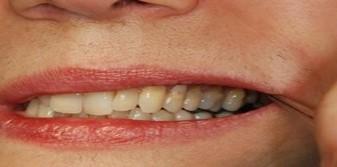Diana comes to see you 4 months after initiating home jaw exercises and using the dental appliance.
Summary of Follow-up Appointment and Jaw Function Assessment
- Diana has responded well to exercise therapy to increase her pain-free ROM.
- The appliance seems to allow her jaw to feel more comfortable at night such that she now seldom awakens with jaw pain. She has not had to use it during the day to be comfortable.
- She finds the NSAID medication to be helpful in controlling her TMJ pain on mornings when it is acute.
- She has been able to control her daytime clenching with a “habit control program."
- Habit control program has 4 parts:
- the patient must recognize that a daytime clenching problem can aggravate their symptoms;
- the patient needs to monitor the habit by placing reminders (stickies) about their life on the computer screen, car stereo, refrigerator;
- when the patient notices the reminder, she checks her bite. If she find herself clenching, she should replace that habit with something counter to the habit, such as a cluck with her tongue;
- the patient can do deep (diaphragmatic) breathing to counteract the stress reaction that led to the clenching.
- Habit control program has 4 parts:
- See text box below and deep breathing exercises, and she has less dull, aching jaw pain at the end of the day.
- Her pelvic pain now seems less frequent and intense and does not seem to influence her jaw pain as it previously had.
- Diana was given a 6-month follow-up visit for her jaw pain. She will use her occlusal appliance nightly and use the NSAID and muscle relaxant for breakthrough TMJ and masticatory muscle pain, respectively.
Peripheral Mechanism: How to Assess the Role of Occlusion in TMD
Ask the patient if her bite feels comfortable and if she can bite evenly on both sides. Have there been any recent changes in the bite (the way the teeth meet)? If so, these are indications that your patient may have an occlusal problem affecting TMD symptoms.
Reference
- Seligman DA, Pullinger AG. The role of functional occlusal relationships in temporomandibular disorders: a review. J Craniomandib Disord. 1991 Fall;5(4):265-79. Review. PubMed PMID: 1814969.
- Seligman DA, Pullinger AG. The role of intercuspal occlusal relationships in temporomandibular disorders: a review. J Craniomandib Disord. 1991 Spring;5(2):96-106. Review. PubMed PMID: 1812142.
- Warreth A, Ramadan M, Bajilan MR, Ibieyou N, El-Swiah J, Elemam RF. Fundamentals of occlusion and restorative dentistry. Part I: basic principles
- J Ir Dent Assoc. 2015 Aug-Sep;61(4):201-8. Erratum in: J Ir Dent Assoc. 2015 Oct-Nov;61(5):259. PMID:26506700
- Türp JC, Schindler H. The dental occlusion as a suspected cause for TMDs: epidemiological and etiological considerations.J Oral Rehabil. 2012 Jul;39(7):502-12. doi: 10.1111/j.1365-2842.2012.02304.x. Epub 2012 Apr 9. Review. PMID:22486535
TMD and Occlusion
Pullinger (1993) evaluated subjects for TMD symptoms and occlusal discrepancies finding the prevalence of TMD to be associated with the following occlusal discrepancies:
- Anterior open bite (space between the upper and lower teeth when biting)
- Overjet (horizontal) anterior-posteriorly > 6 - 7mm between anterior teeth (small lower jaw with “buck” front teeth)
- Centric relation (swallowing position) to normal biting position slide > 2 mm
- Unilateral lingual crossbite (malposition of tooth/teeth causing sideways shift from first tooth contact to normal biting position)
- 5 or more missing posterior teeth
Anterior open bite characterized by an open space between the patient’s front teeth ; the patient only contacts on her left 2nd molar contributing to an unstable bite (unstable occlusion)

This patient has no tooth contact on her left posterior teeth contributing to an unstable bite.

When are Occlusal Treatments Indicated?
Acute TMD symptoms after restorative dentistry can indicate the need for immediate adjustment of dental restorations. Appliance (night guard) therapy is a reversible way to stabilize the occlusion. Definitive occlusal treatments are done as a last resort, and then only if the patient is dependent on appliance wear to control TMD symptoms.
References
- Koh H, Robinson PG. Occlusal adjustment for treating and preventing temporomandibular joint disorders. Cochrane Database Syst Rev. 2003;(1):CD003812. Review. PubMed PMID: 12535488.
- Macedo CR, Silva AB, Machado MA, Saconato H, Prado GF. Occlusal splints for treating sleep bruxism (tooth grinding). Cochrane Database Syst Rev. 2007 Oct 17;(4):CD005514. Review. PubMed PMID: 17943862.
- Klasser GD, Greene CS, Lavigne GJ. Oral appliances and the management of sleep bruxism in adults: a century of clinical applications and search for mechanisms. Int J Prosthodont. 2010 Sep-Oct;23(5):453-62. Review. PubMed PMID: 20859563.
- Warreth A, Ramadan M, Bajilan MR, Ibieyou N, El-Swiah J, Elemam RF. Fundamentals of occlusion and restorative dentistry. Part I: basic principles
- J Ir Dent Assoc. 2015 Aug-Sep;61(4):201-8. Erratum in: J Ir Dent Assoc. 2015 Oct-Nov;61(5):259. PMID:26506700
Definitive Occlusal Treatments to Stabilize Diana’s Occlusion
Assuming Diana is dependent upon daytime wear of her occlusal appliance to stabilize her occlusion.
- Steps indicated in deciding the treatment needed:
- diagnostic mounting, laboratory equilibration of casts to acquire bilateral occlusion on posterior teeth, assessment of amount of tooth changes needed to acquire stability, stepwise restoration of teeth to minimize changes
- Treatments available with which to stabilize her occlusion:
- composite bonding on occlusal surfaces of posterior teeth or onlays & caps on posterior teeth both to establish bilateral posterior teeth contact, orthodontics, orthognathic surgery
- Critical factors in deciding which technique to use:
- most important is the size of the discrepancy between the dental arches, the patient’s esthetic concerns vs functional concerns, available finances, and available time)
References
- Stohler CS. Orofacial pain and the prospects of precision medicineJ Oral Facial Pain Headache. 2015 Fall;29(4):321. PMID: 26625499
- Wacyl Mesnay (2012). Current role of orthodontists in treating temporomandibular disorders. Journal of Dentofacial Anomalies and Orthodontics, 15, 205 doi:10.1051/odfen/2012105 Link to this article: http://www.jdaojournal.org/10.1051/odfen/2012105
- Ash MM Jr. Occlusion, TMDs, and dental educationHead Face Med. 2007 Jan 3;3:1. Review.PMID:17201917

